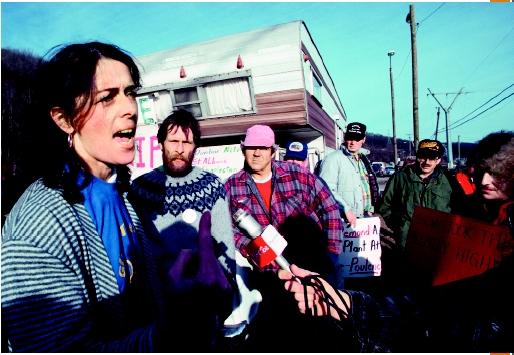Gibbs, Lois GRASSROOTS ENVIRONMENTAL ACTIVIST AND THE "MOTHER OF SUPERFUND" (1951–)
Lois Gibbs is a leading activist in defending the public from the dangers of toxic waste. In 1978, she discovered that her neighborhood of Love Canal in Niagara Falls, New York, was built on top of 21,000 tons of hazardous chemical waste. Faced with the health threat to her family and community, Gibbs transformed from a shy housewife to the antipollution activist now known as the "mother of Superfund." Superfund, or the Comprehensive Environmental Response, Compensation, and Liability Act (CERCLA), is the federal program to clean up toxic waste sites. Her work through the Center for Health, Environment and Justice (CHEJ) helps grassroots organizations nationwide demand accountability from industrial polluters and the U.S. government.
Love Canal was the brainchild of William T. Love, an entrepreneur who wanted to link the upper and lower Niagara River for a hydroelectric power project in the late 1800s. Halted by an economic depression, the sixty-foot-wide by three-thousand-foot-long pit became a dump site for the Niagara Falls municipality, the U.S. Army, and the Hooker Chemical Corporation. After the pit was filled to capacity and covered with topsoil, Hooker sold the land to the Niagara Falls Board of Education. A school and single-family homes were built on the site in the 1950s.

In 1978, after reading a Niagara Gazette series on local hazardous waste problems, Gibbs wondered if her son's epilepsy , urinary tract, and respiratory problems could be traced to his school's location on the former Love Canal dump site. She began petitioning for the closure of the elementary school, and gained the support of fellow concerned neighbors and friends. In the process, Gibbs learned about other health problems in the community—including liver disorders, blood disease, asthma, and urinary problems—and of residents' fears that their homes would soon be worthless, trapping them in the polluted neighborhood. In August 1978, Gibbs and two neighbors took the petition with 161 signatures to the Commissioner of the State Department of Health, who immediately closed the school and recommended that pregnant women and children living close to the school leave the area. Within a week of that meeting, President Jimmy Carter declared Love Canal a federal emergency area, or emergency declaration area (EDA), and allocated funds to relocate the 239 families living in the first two rings of homes around the school.
But another level of struggle was about to begin. In Gibbs' memoir, Love Canal: My Story, she relates the two-year nightmare for the neighbors remaining on the canal. The cleanup effort to drain toxins from the area only released more dangerous chemicals. As president of the Love Canal Homeowners Association, Gibbs spearheaded a fight to get the government to purchase Love Canal homes at a fair price. Dramatic events of 1980, a key election year, forced government action. The U.S. Environmental Protection Agency (EPA) released its study showing that residents exhibited chromosomal damage and angry Love Canal residents took two EPA representatives hostage. Gibbs took the Democratic National Convention by surprise in order to appeal for mortgage assistance for the residents of Love Canal. Her tenacious work publicized the severity of the pollution problem at Love Canal that inaction by Congress and President Carter would have had a political cost. President Carter finally agreed to fund permanent relocations for all Love Canal families, and the federal Superfund program was established to clean up toxic waste sites similar to Love Canal. Superfund would serve to enforce strict polluter liability so that no company could abandon a site as Hooker attempted to do in the case of Love Canal.
After moving her family to Washington, D.C., Gibbs founded the Citizens Clearinghouse on Hazardous Waste (1981), later renamed the Center for Health, Environment, and Justice (CHEJ), an organization dedicated to helping community organizations facing toxic waste issues, especially exposure to dioxin. In 1990, Gibbs was awarded the Goldman Environmental Prize.
SEE ALSO C OMPREHENSIVE E NVIRONMENTAL R ESPONSE , C OMPENSATION, AND L IABILITY A CT (CERCLA) ; S UPERFUND .
Bibliography
Gibbs, Lois Marie, as told to Murray Levine. (1981). Love Canal: My Story. Albany: State University of New York Press.
Gibbs, Lois Marie. (1998). Love Canal: The Story Continues. Stony Creek, CT: New Society Publishers.
Gibbs, Lois Marie, and the Citizens Clearinghouse for Hazardous Waste. (1995). Dying from Dioxin: A Citizens Guide to Reclaiming Our Health and Rebuilding Democracy. Cambridge, MA: South End Press.
Internet Resources
Center for Health, Environment, and Justice Web site. Available from http://www.chej.org .
Science and Engineering Library, University of Buffalo. "Love Canal @ 20." Available from http://ublib.buffalo.edu/libraries .
Anne Becher and Joseph Richey
Comment about this article, ask questions, or add new information about this topic: